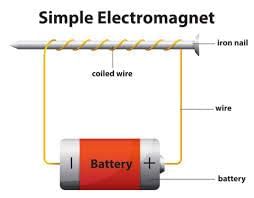Class 8 Exam > Class 8 Notes > Year 8 Physics (Cambridge) > Magnets
Magnets | Year 8 Physics (Cambridge) - Class 8 PDF Download
Magnets and Magnetic Materials
Definition of Magnets
- A magnet is a material or object that produces a magnetic field, which attracts ferromagnetic materials like iron, nickel, and cobalt.
Types of Magnets
- Permanent Magnets: Always magnetic. Made from materials like steel or alloys like neodymium.
- Temporary Magnets: Act like magnets when in a strong magnetic field but lose magnetism once the field is removed. Examples include soft iron.

Magnetic Materials
- Ferromagnetic Materials: Strongly attracted by a magnet and can be permanently magnetized. Examples include iron, nickel, and cobalt.
- Non-Magnetic Materials: Not attracted to magnets. Examples include wood, plastic, and glass.
Properties of Magnets
- Polarity: Magnets have two poles, North and South. Like poles repel each other, while opposite poles attract.
- Magnetic Field: The area around a magnet where its magnetic force can be felt. It is represented by lines that show the direction and strength of the field.
- Magnetic Domains: Regions within a material where the magnetic moments are aligned in the same direction.
Examples
- Bar Magnet: Common type of permanent magnet used in school experiments.
- Magnetic Compass: Uses a small bar magnet to point towards the Earth's magnetic north pole.
- Magnetic Whiteboards: Use magnets to attach papers and notes.
Question for MagnetsTry yourself: Which type of magnet is always magnetic and does not lose its magnetism once the magnetic field is removed?View Solution
Electromagnets
Definition of Electromagnets
- Electromagnets are magnets created by passing an electric current through a coil of wire wrapped around a metal core.

How Electromagnets Work
- When an electric current flows through the coil, it generates a magnetic field.
- The strength of the electromagnet can be increased by increasing the number of coils or the current passing through the wire.
- Electromagnets can be turned on and off by controlling the electric current.
Components of an Electromagnet
- Coil of Wire (Solenoid): Conducts the electric current and generates the magnetic field.
- Iron Core: Placed inside the coil to amplify the magnetic field created by the current.
- Power Source: Provides the electric current (e.g., battery or power supply).
Applications of Electromagnets
- Electric Motors: Convert electrical energy into mechanical energy.
- Relays and Switches: Used in various electrical devices to open or close circuits.
- MRI Machines: Use powerful electromagnets to create detailed images of the inside of the human body.
- Magnetic Lifting Devices: Used in scrap yards to lift heavy metal objects.
Examples
- Doorbell: Uses an electromagnet to move a striker and produce sound.
- Crane in Junkyard: Lifts heavy iron and steel objects using a powerful electromagnet.
- Electric Door Locks: Use electromagnets to secure doors, allowing them to be unlocked with an electric signal.
Question for MagnetsTry yourself: Which application of electromagnets is used to create detailed images of the inside of the human body?View Solution
Differences Between Permanent Magnets and Electromagnets
- Control: Electromagnets can be turned on and off; permanent magnets cannot.
- Strength: The magnetic field of an electromagnet can be adjusted; the field of a permanent magnet is constant.
- Materials: Permanent magnets are made from ferromagnetic materials; electromagnets require a power source and a coil of wire.
Summary
Magnets are crucial in many everyday applications, from simple bar magnets to complex electromagnets used in various technologies. Understanding the properties and uses of magnets and electromagnets helps us harness their power for numerous practical purposes.
The document Magnets | Year 8 Physics (Cambridge) - Class 8 is a part of the Class 8 Course Year 8 Physics (Cambridge).
All you need of Class 8 at this link: Class 8
|
8 videos|39 docs|11 tests
|
FAQs on Magnets - Year 8 Physics (Cambridge) - Class 8
| 1. What is the difference between a magnet and an electromagnet? |  |
Ans. A magnet is a material that produces a magnetic field, while an electromagnet is a coil of wire with an electric current running through it, which creates a magnetic field.
| 2. How do magnets work? |  |
Ans. Magnets work by aligning the magnetic domains in their material to create a magnetic field. This field attracts or repels other magnets or magnetic materials.
| 3. Can you turn a magnet off? |  |
Ans. Unlike electromagnets, traditional magnets cannot be turned off. Once a material becomes magnetized, it will remain magnetic unless subjected to high temperatures or strong magnetic fields in the opposite direction.
| 4. How can you increase the strength of an electromagnet? |  |
Ans. The strength of an electromagnet can be increased by increasing the number of coils in the wire, increasing the current running through the wire, or using a core material with high magnetic permeability.
| 5. What are some common uses of magnets and electromagnets? |  |
Ans. Magnets are commonly used in refrigerator doors, speakers, and magnetic toys. Electromagnets are used in electric motors, MRI machines, and lifting magnets in scrapyards.
Related Searches
















